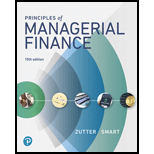
a)
To discuss:
Required
Introduction:
b)
To discuss:
Graph on security market line.
Introduction:
The security market line (SML) is a line, which shows the relationship between the risk, which is measured by beta and the required rate of return for the individual securities.
c)
To discuss:
Beta.
Introduction:
Beta is an indicator of the risk tha measures the systematic risk of a risky investment by comparing the risky investment with the average risky asset in the market. Thus it measures the non diversifiable risk.
d)
To discuss:
Calculation of the new required rate of return attributed to increased risk aversion.
Introduction:
The security market line (SML) is a line, which shows the relationship between the risk, which is measured by beta and the required rate of return for the individual securities.
Capital asset pricing model or CAPM establishes the relationship between the projected return for assets and systematic risk on the stocks.
e)
To discuss:
Impact of the changes on the required rate of return.
Introduction:
The security market line (SML) is a line, which shows the relationship between the risk, which is measured by beta and the required rate of return for the individual securities.
Capital asset pricing model or CAPM establishes the relationship between the projected return for assets and systematic risk on the stocks.
Want to see the full answer?
Check out a sample textbook solution
Chapter 8 Solutions
Gitman: Principl Manageri Finance_15 (15th Edition) (What's New in Finance)
- What is the primary goal of financial management? A) Maximizing revenuesB) Minimizing costsC) Maximizing shareholder wealthD) Increasing market share need help!arrow_forwardThe time value of money concept assumes that: A) A dollar today is worth more than a dollar in the future B) A dollar in the future is worth more than a dollar today C) Money loses value only when interest rates rise D) Money value remains constant over time need help!!arrow_forwardWhat does ROI stand for in finance? A) Return on InvestmentB) Revenue on InvestmentC) Rate of InterestD) Risk of Investment need answer!arrow_forward
- The time value of money concept assumes that: A) A dollar today is worth more than a dollar in the futureB) A dollar in the future is worth more than a dollar todayC) Money loses value only when interest rates riseD) Money value remains constant over timearrow_forwardWhat is the primary goal of financial management? A) Maximizing revenuesB) Minimizing costsC) Maximizing shareholder wealthD) Increasing market sharearrow_forwardA bond’s face value is: A) The price at which the bond is bought B) The amount paid to the bondholder at maturity C) The interest rate of the bond which option is correct?arrow_forward
- What does ROI stand for in finance? A) Return on InvestmentB) Revenue on InvestmentC) Rate of InterestD) Risk of Investmentneed exparrow_forwardA bond’s face value is: A) The price at which the bond is bought B) The amount paid to the bondholder at maturity C) The interest rate of the bond D) The amount of annual coupon paymentsi need help in this question!arrow_forwardA bond’s face value is: A) The price at which the bond is bought B) The amount paid to the bondholder at maturity C) The interest rate of the bond D) The amount of annual coupon paymentsarrow_forward
- A public company’s value can be calculated by different approaches depending on the data available and are often shared through quarterly or annual reports, or financial statements. If a financial and investment analyst for a publicly traded company, understanding that I may be asked to give a presentation on how the company uses performance metrics in corporate valuation. How would I present return on equity (ROE) and earnings per share (EPS) to a group of investors or senior management. Reviewiing a publicly traded company’s ROE and EPS. Although What do these results say about the company?arrow_forwardA stock’s beta coefficient is a measure of its: A) Dividend yield B) Risk in relation to the market C) Earnings growth rate D) Market pricearrow_forwardNo AI Which of the following is NOT a characteristic of common stock? A) Voting rights B) Dividends C) Guaranteed return on investment D) Ownership in the companyarrow_forward
 Survey of Accounting (Accounting I)AccountingISBN:9781305961883Author:Carl WarrenPublisher:Cengage Learning
Survey of Accounting (Accounting I)AccountingISBN:9781305961883Author:Carl WarrenPublisher:Cengage Learning


